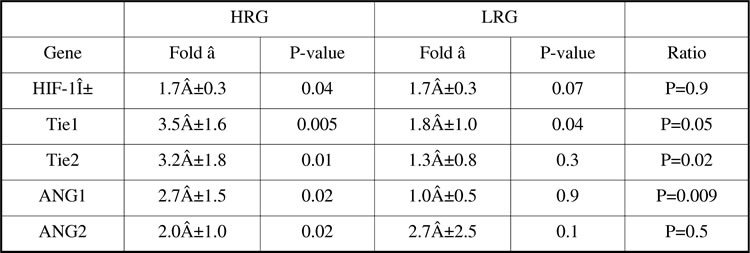The molecular regulation of human skeletal muscle angiogenesis has not been fully described. Despite this lack of knowledge many gene therapy trials have been initiated, many with disappointing results (Rajagopalan et al 2003). Ang1, the endothelial cell Tie2 agonist, is thought to facilitate the maturation of vascular endothelial growth factor (VEGF) stimulated collateral vessel growth through regulation of smooth muscle cell recruitment and by acting as a chemo-attractant factor, directing endothelial cell orientation (Nishishita et al 2004). The physiological regulation of this system, in human muscle tissue has not been previously examined. 24 male subjects undertook supervised aerobic training; cycling at 75% of peak VO2 (4 times per week, 6 weeks). The study was approved by the Institute ethics committee. Peak aerobic capacity, submaximal heart rate response (@75% of peak VO2) and 15min exercise performance (KJ) were quantified. Subjects were ranked on the basis of the sum of their % improvements across these 3 variables. Muscle gene expression was studied in the top 8 (HRG, 24±1yr, 183±3cm, 77±6kg, Baseline VO2peak =3.5±0.3 l/min) and compared with the 8 lowest ranked subjects (LRG, 23±1yr, 180±3cm, 77±3kg, Baseline VO2peak =3.7±0.1 l/min). Cumulative increase in aerobic fitness index was 10±2% in the LRG and 55±4% in the HRG (P<0.0001). Changes in hypoxia inducible factor 1α (HIF-1α) gene expression, the master regulator of hypoxia responsive genes, did not relate to the increase in aerobic fitness. Ang1 and Tie2 expression were upregulated in the high responder group, indicating that activation of the angiopoietins system, 24 hours following exercise, may be essential for a functional angiogenesis response, following the earlier increase in VEGF expression (Gustafsson et al 1999). The lack of difference in Ang2 between groups, suggests that the vessel stabilizing/maturing role of ANG1 is a more important hallmark of successful adaptation to exercise. In conclusion, pro-angiogenesis processes may determine gains in aerobic fitness in humans following aerobic exercise.
University of Nottingham (2004) J Physiol 558P, C8
Communications: The angiopoietin system is transcriptionally regulated by endurance exercise in humans
Gustafsson,Thomas ; Fischer,Helene ; Sundberg,Carl Johan; Jansson,Eva ; Timmons,James A;
1. Department of Physiology and Pharmacology, Karolinska Institutet, Stockholm, Sweden. 2. Centre for Genomics and Bioinformatics, Karolinska Institutet, Stockholm, Sweden.
View other abstracts by:
Table 1Data was generated using TaqMan Real Time PCR (Gustafsson et al 1999). Values represent mean ± SEM. P value generated using un-paired t-test. Ratio P values reflect the comparison between the fold change observed in the HRG versus the LRG using un-paired t-test.
Where applicable, experiments conform with Society ethical requirements.

